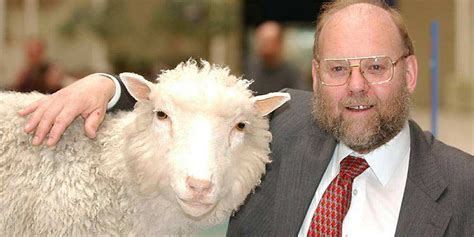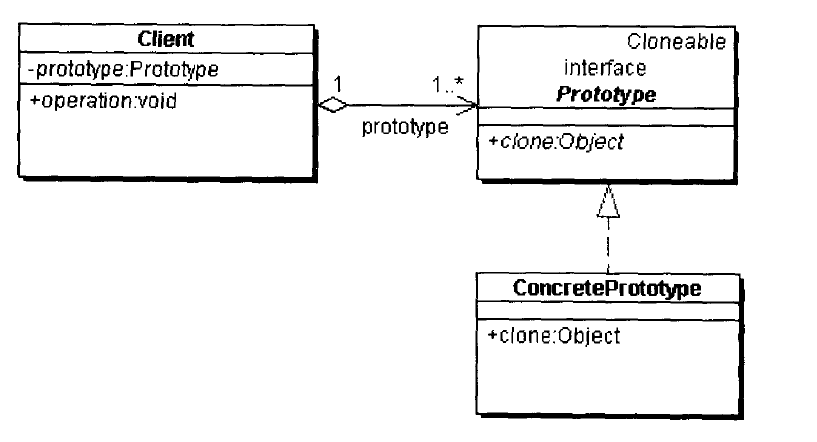- ubuntu12.04环境下使用kvm ioctl接口实现最简单的虚拟机
- Ubuntu 通过无线网络安装Ubuntu Server启动系统后连接无线网络的方法
- 在Ubuntu上搭建网桥的方法
- ubuntu 虚拟机上网方式及相关配置详解
CFSDN坚持开源创造价值,我们致力于搭建一个资源共享平台,让每一个IT人在这里找到属于你的精彩世界.
这篇CFSDN的博客文章java设计模式:原始模型模式由作者收集整理,如果你对这篇文章有兴趣,记得点赞哟.
通过给出一个原型对象指明所要创建的对象的类型,然后通过复制这个原型对象来获取的更多的同类型的对象.
这让我不由自主的想起克隆技术,还记得克隆羊吗?我们接下来讲的内容和克隆羊不能说关系密切,只能说毫无关系.

设计模式和编程语言无关,但是二当家的依然用Java语言去实战举例。而且Java有标准的实现原始模型模式的方法.

Prototype:抽象类或者一个接口,给出具体模型需要的接口。ConcretePrototype:继承抽象原型模型角色,被复制的对象。Client:提出复制请求。
我们用家庭作业为抽象原型角色(Prototype)。我们这里的作业是可以抄的。大家不要学哈.
|
1
2
3
4
5
6
7
8
9
10
11
12
13
14
15
16
17
18
|
package
com.secondgod.prototype;
/**
* 作业
*
* @author 二当家的白帽子 https://le-yi.blog.csdn.net/
*/
public
interface
IHomework {
/**
* 抄一份
* @return
*/
IHomework copy();
/**
* 修改所有者
* @param owner
*/
void
setOwner(String owner);
}
|
我们用语文作业作为具体原型角色(ConcretePrototype).
|
1
2
3
4
5
6
7
8
9
10
11
12
13
14
15
16
17
18
19
20
21
22
23
24
25
26
27
28
29
30
31
32
33
34
35
36
37
38
39
40
41
42
43
44
45
46
47
48
49
50
51
52
|
package
com.secondgod.prototype;
import
java.text.MessageFormat;
/**
* 语文作业
*
* @author 二当家的白帽子 https://le-yi.blog.csdn.net/
*/
public
class
ChineseHomework
implements
IHomework {
/**
* 作业的所有者
*/
private
String owner;
/**
* 作业标题/作业要求
*/
private
String title;
/**
* 作业内容
*/
private
String content;
public
ChineseHomework(String owner, String title, String content) {
this
.owner = owner;
this
.title = title;
this
.content = content;
}
public
String getOwner() {
return
owner;
}
public
void
setOwner(String owner) {
this
.owner = owner;
}
public
String getTitle() {
return
title;
}
public
void
setTitle(String title) {
this
.title = title;
}
public
String getContent() {
return
content;
}
public
void
setContent(String content) {
this
.content = content;
}
public
String toString() {
return
MessageFormat.format(
"owner:{0},title:{1},content:{2}"
, owner, title, content);
}
@Override
public
IHomework copy() {
ChineseHomework homework =
new
ChineseHomework(
this
.getOwner(),
this
.getTitle(),
this
.getContent());
return
homework;
}
}
|
我们测试一下.
|
1
2
3
4
5
6
7
8
9
10
11
12
13
14
15
16
17
|
package
com.secondgod.prototype;
/**
* 测试原始模型
*
* @author 二当家的白帽子 https://le-yi.blog.csdn.net/
*/
public
class
Test {
public
static
void
main(String[] args) {
// 老师让写作业,大当家按时完成
IHomework homework =
new
ChineseHomework(
"大当家的"
,
"作文-最崇拜的人"
,
"不瞒你们说,我最崇拜的是二当家的"
);
// 二当家的没按时完成,决定去抄大当家的作业~
IHomework newHomework = homework.copy();
newHomework.setOwner(
"二当家的"
);
System.out.println(homework);
System.out.println(newHomework);
}
}
|

和我们的预期一致 。
在Object类中有这样一个方法,Java中所有的类都继承自Object类,也就是说所有的类内部都可以复制自己。但是却不能直接调用别的类的克隆方法。也就是说有统一的方式,但是默认不可用.

我们改一下语文作业类,使用clone方法去尝试,克隆自己.
|
1
2
3
4
5
6
7
8
9
10
11
12
13
14
15
16
17
18
19
20
21
22
23
24
25
26
27
28
29
30
31
32
33
34
35
36
37
38
39
40
41
42
43
44
45
46
47
48
49
50
51
52
53
54
55
|
package
com.secondgod.prototype;
import
java.text.MessageFormat;
/**
* 语文作业
*
* @author 二当家的白帽子 https://le-yi.blog.csdn.net/
*/
public
class
ChineseHomework
implements
IHomework {
/**
* 作业的所有者
*/
private
String owner;
/**
* 作业标题/作业要求
*/
private
String title;
/**
* 作业内容
*/
private
String content;
public
ChineseHomework(String owner, String title, String content) {
this
.owner = owner;
this
.title = title;
this
.content = content;
}
public
String getOwner() {
return
owner;
}
public
void
setOwner(String owner) {
this
.owner = owner;
}
public
String getTitle() {
return
title;
}
public
void
setTitle(String title) {
this
.title = title;
}
public
String getContent() {
return
content;
}
public
void
setContent(String content) {
this
.content = content;
}
public
String toString() {
return
MessageFormat.format(
"owner:{0},title:{1},content:{2}"
, owner, title, content);
}
@Override
public
IHomework copy() {
try
{
return
(ChineseHomework)
super
.clone();
}
catch
(CloneNotSupportedException e) {
throw
new
RuntimeException(e);
}
}
}
|

这时候会报错,因为我们还少做一件事。我们需要把语文作业类实现Cloneable接口,然而这个接口里没有任何抽象方法,仅仅是一个标记接口。这就像注解一样,就是为了明确声明可以克隆.

实现接口后,则可以正确运行.
|
1
2
3
4
5
6
7
8
9
10
11
12
13
14
15
16
17
18
19
20
21
22
23
24
25
26
27
28
29
30
31
32
33
34
35
36
37
38
39
40
41
42
43
44
45
46
47
48
49
50
51
52
53
54
55
|
package
com.secondgod.prototype;
import
java.text.MessageFormat;
/**
* 语文作业
*
* @author 二当家的白帽子 https://le-yi.blog.csdn.net/
*/
public
class
ChineseHomework
implements
IHomework, Cloneable {
/**
* 作业的所有者
*/
private
String owner;
/**
* 作业标题/作业要求
*/
private
String title;
/**
* 作业内容
*/
private
String content;
public
ChineseHomework(String owner, String title, String content) {
this
.owner = owner;
this
.title = title;
this
.content = content;
}
public
String getOwner() {
return
owner;
}
public
void
setOwner(String owner) {
this
.owner = owner;
}
public
String getTitle() {
return
title;
}
public
void
setTitle(String title) {
this
.title = title;
}
public
String getContent() {
return
content;
}
public
void
setContent(String content) {
this
.content = content;
}
public
String toString() {
return
MessageFormat.format(
"owner:{0},title:{1},content:{2}"
, owner, title, content);
}
@Override
public
IHomework copy() {
try
{
return
(ChineseHomework)
super
.clone();
}
catch
(CloneNotSupportedException e) {
throw
new
RuntimeException(e);
}
}
}
|

和我们自己实现copy效果一样。clone是一个native方法,是交给本地实现的,通常是直接内存拷贝.
浅拷贝:创建一个新对象,然后将当前对象的非静态字段复制到该新对象,如果字段是值类型的,那么对该字段执行复制;如果该字段是引用类型的话,则复制引用但不复制引用的对象。因此,原始对象及其副本引用同一个对象.
深拷贝:创建一个新对象,然后将当前对象的非静态字段复制到该新对象,无论该字段是值类型的还是引用类型,都复制独立的一份。当你修改其中一个对象的任何内容时,都不会影响另一个对象的内容.
二当家的理解方式是,浅拷贝就是仅拷贝当前对象的内容,深拷贝就是递归拷贝当前对象和当前对象的引用类型属性的内容,直到全部都是基本数据类型的属性为止。另外,仅仅使用clone方法是浅拷贝.
package com.secondgod.prototype;/** * 测试原始模型 * * @author 二当家的白帽子 https://le-yi.blog.csdn.net/ */public class Test implements Cloneable { private Field field; public Field getField() { return field; } public void setField(Field field) { this.field = field; } public Test clone() throws CloneNotSupportedException { return (Test) super.clone(); } public static void main(String[] args) throws CloneNotSupportedException { Test t = new Test(); t.setField(new Field()); Test cloneT = t.clone(); System.out.println(t == cloneT); System.out.println(t.getField() == cloneT.getField()); }}class Field {}

源对象和克隆出的新对象field属性值是同一个对象。所以是浅拷贝.
让每个引用类型属性内部都重写clone() 方法,然后需要对所有引用类型属性都调用clone方法.
|
1
2
3
4
5
6
7
8
9
10
11
12
13
14
15
16
17
18
19
20
21
22
23
24
25
26
27
|
package
com.secondgod.prototype;
/**
* 测试原始模型
*
* @author 二当家的白帽子 https://le-yi.blog.csdn.net/
*/
public
class
Test
implements
Cloneable {
private
Field field;
public
Field getField() {
return
field;
}
public
void
setField(Field field) {
this
.field = field;
}
public
Test clone()
throws
CloneNotSupportedException {
return
(Test)
super
.clone();
}
public
static
void
main(String[] args)
throws
CloneNotSupportedException {
Test t =
new
Test();
t.setField(
new
Field());
Test cloneT = t.clone();
System.out.println(t == cloneT);
System.out.println(t.getField() == cloneT.getField());
}
}
class
Field {
}
|

这种方式需要递归每个引用类型的属性,要把他们的类都实现深拷贝,只到仅有基本数据类型为止.
利用序列化,这是个偷懒的办法。但是二当家的觉得更安全,如果你确定是要深拷贝,使用该方式可以防止某处漏实现clone方法,而变成不完全的深拷贝.
|
1
2
3
4
5
6
7
8
9
10
11
12
13
14
15
16
17
18
19
20
21
22
23
24
25
26
27
28
29
30
31
32
33
34
35
36
37
38
39
40
41
42
|
package
com.secondgod.prototype;
/**
* 测试原始模型
*
* @author 二当家的白帽子 https://le-yi.blog.csdn.net/
*/
public
class
Test
implements
Cloneable {
private
Field field;
public
Field getField() {
return
field;
}
public
void
setField(Field field) {
this
.field = field;
}
public
Test clone()
throws
CloneNotSupportedException {
return
(Test)
super
.clone();
}
public
Test deepClone()
throws
CloneNotSupportedException {
Test t =
new
Test();
t.setField(
this
.getField().deepClone());
return
t;
}
public
static
void
main(String[] args)
throws
CloneNotSupportedException {
Test t =
new
Test();
t.setField(
new
Field());
Test cloneT = t.clone();
System.out.println(t == cloneT);
System.out.println(t.getField() == cloneT.getField());
Test deepCloneT = t.deepClone();
System.out.println(t == deepCloneT);
System.out.println(t.getField() == deepCloneT.getField());
}
}
class
Field
implements
Cloneable {
public
Field clone()
throws
CloneNotSupportedException {
return
(Field)
super
.clone();
}
public
Field deepClone()
throws
CloneNotSupportedException {
// 没有引用类型属性
return
this
.clone();
}
}
|

到底使用浅拷贝还是深拷贝,要根据实际情况。但是有一点是确定的,深拷贝需要创建更多对象,占用更多内存.
本篇文章就到这里了,希望能给你带来帮助,也希望您能够多多关注我的更多内容! 。
原文链接:https://blog.csdn.net/leyi520/article/details/119536473 。
最后此篇关于java设计模式:原始模型模式的文章就讲到这里了,如果你想了解更多关于java设计模式:原始模型模式的内容请搜索CFSDN的文章或继续浏览相关文章,希望大家以后支持我的博客! 。
可不可以命名为MVVM模型?因为View通过查看模型数据。 View 是否应该只与 ViewModelData 交互?我确实在某处读到正确的 MVVM 模型应该在 ViewModel 而不是 Mode
我正在阅读有关设计模式的文章,虽然作者们都认为观察者模式很酷,但在设计方面,每个人都在谈论 MVC。 我有点困惑,MVC 图不是循环的,代码流具有闭合拓扑不是很自然吗?为什么没有人谈论这种模式: mo
我正在开发一个 Sticky Notes 项目并在 WPF 中做 UI,显然将 MVVM 作为我的架构设计选择。我正在重新考虑我的模型、 View 和 View 模型应该是什么。 我有一个名为 Not
不要混淆:How can I convert List to Hashtable in C#? 我有一个模型列表,我想将它们组织成一个哈希表,以枚举作为键,模型列表(具有枚举的值)作为值。 publi
我只是花了一些时间阅读这些术语(我不经常使用它们,因为我们没有任何 MVC 应用程序,我通常只说“模型”),但我觉得根据上下文,这些意味着不同的东西: 实体 这很简单,它是数据库中的一行: 2) In
我想知道你们中是否有人知道一些很好的教程来解释大型应用程序的 MVVM。我发现关于 MVVM 的每个教程都只是基础知识解释(如何实现模型、 View 模型和 View ),但我对在应用程序页面之间传递
我想realm.delete() 我的 Realm 中除了一个模型之外的所有模型。有什么办法可以不列出所有这些吗? 也许是一种遍历 Realm 中当前存在的所有类型的方法? 最佳答案 您可以从您的 R
我正在尝试使用 alias 指令模拟一个 Eloquent 模型,如下所示: $transporter = \Mockery::mock('alias:' . Transporter::class)
我正在使用 stargazer 创建我的 plm 汇总表。 library(plm) library(pglm) data("Unions", package = "pglm") anb1 <- pl
我读了几篇与 ASP.NET 分层架构相关的文章和问题,但是读得太多后我有点困惑。 UI 层是在 ASP.NET MVC 中开发的,对于数据访问,我在项目中使用 EF。 我想通过一个例子来描述我的问题
我收到此消息错误: Inceptionv3.mlmodel: unable to read document 我下载了最新版本的 xcode。 9.4 版测试版 (9Q1004a) 最佳答案 您没有
(同样,一个 MVC 验证问题。我知道,我知道......) 我想使用 AutoMapper ( http://automapper.codeplex.com/ ) 来验证我的创建 View 中不在我
需要澄清一件事,现在我正在处理一个流程,其中我有两个 View 模型,一个依赖于另一个 View 模型,为了处理这件事,我尝试在我的基本 Activity 中注入(inject)两个 View 模型,
如果 WPF MVVM 应该没有代码,为什么在使用 ICommand 时,是否需要在 Window.xaml.cs 代码中实例化 DataContext 属性?我已经并排观看并关注了 YouTube
当我第一次听说 ASP.NET MVC 时,我认为这意味着应用程序由三个部分组成:模型、 View 和 Controller 。 然后我读到 NerdDinner并学习了存储库和 View 模型的方法
Platform : ubuntu 16.04 Python version: 3.5.2 mmdnn version : 0.2.5 Source framework with version :
我正在学习本教程:https://www.raywenderlich.com/160728/object-oriented-programming-swift ...并尝试对代码进行一些个人调整,看看
我正试图围绕 AngularJS。我很喜欢它,但一个核心概念似乎在逃避我——模型在哪里? 例如,如果我有一个显示多个交易列表的应用程序。一个列表向服务器查询匹配某些条件的分页事务集,另一个列表使用不同
我在为某个应用程序找出最佳方法时遇到了麻烦。我不太习惯取代旧 TLA(三层架构)的新架构,所以这就是我的来源。 在为我的应用程序(POCO 类,对吧??)设计模型和 DAL 时,我有以下疑问: 我的模
我有两个模型:Person 和 Department。每个人可以在一个部门工作。部门可以由多人管理。我不确定如何在 Django 模型中构建这种关系。 这是我不成功的尝试之一 [models.py]:

我是一名优秀的程序员,十分优秀!